Elgin, Moray
| Elgin | |
| Scottish Gaelic: Eilginn | |
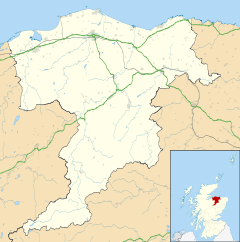 Elgin
|
|
| Population | 25,678 (Census 2001) |
|---|---|
| OS grid reference | |
| Council area | Moray |
| Lieutenancy area | Moray |
| Country | Scotland |
| Sovereign state | United Kingdom |
| Post town | ELGIN |
| Postcode district | IV30 |
| Dialling code | 01343 |
| Police | Grampian |
| Fire | Grampian |
| Ambulance | Scottish |
| EU Parliament | Scotland |
| UK Parliament | Moray |
| Scottish Parliament | Moray |
| Highlands and Islands | |
| List of places: UK • Scotland • | |
Elgin (pronounced /ˈɛlɡɪn/; Scottish Gaelic: Eilginn) is a former cathedral city and Royal Burgh in Moray, Scotland and is the administrative and commercial centre for Moray. The town originated to the south of the River Lossie on the higher ground above the flood plain. Elgin is first documented in the Cartulary of Moray in 1190. It was created a Royal Burgh in the 12th century by King David I of Scotland and by that time had a castle on top of the present day Lady Hill to the west of the city.
Contents |
History
In August 1040, MacBeth's army defeated and killed Duncan I at Bothganowan (Pitgaveny), near Elgin. Elgin is first recorded in a charter by King David in 1151 when he granted an annuity to the Priory of Urquhart.[1] It had been made a royal burgh around 1130 by David I following his defeat of Óengus of Moray. It was during David's reign that the castle was established at the top of what is now Lady Hill. The town received a royal charter from Alexander II in 1224 when he granted the land for a new cathedral to Andrew, Bishop of Moray. This finally settled the episcopal see which had been at various times at Kinneddar, Birnie and Spynie. Elgin was a popular residence to the early Scottish monarchs; David I, William I, Alexander II and Alexander III all held their courts there and enjoyed the hunting in the royal forests.
Of all these kings, it was Alexander II who was Elgin's greatest benefactor and who would return time and again to his royal castle. It was he who was responsible for the establishment of the two religious houses of the town; the Dominicans or Blackfriars in the west side and the Franciscans or Greyfriars in the east. Still further to the east stood the Hospital of Maison Dieu, or House of God, which again was founded during the reign of Alexander II and was for the reception of poor men and women.[2]
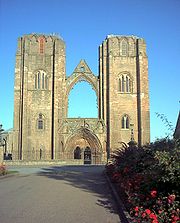
On 19 July 1224, the foundation stone of the new Elgin Cathedral was ceremoniously laid with completion sometime after 1242. However, the building was completely destroyed by fire in 1270 but the reasons for this are unrecorded. The buildings which now remain as ruins date from the reconstruction following that fire. The Chartulary of Moray described the completed cathedral as "Mirror of the country and the glory of the kingdom".
Edward I of England travelled twice to Elgin. It was during his first visit in 1296 that he was impressed by what he saw. Preserved in the Cotton library now held in the British Library was the journal of his stay, describing the castle and the town of Elgin as "bon chastell et bonne ville" — good castle and good town. His second visit in September 1303 was rather different as the castle's wooden interior had been burned while being held by the English governor, Henry de Rye. As a result, Edward stayed elsewhere, marking the end of any English association. Edward I of England only stayed in Elgin for two days and then camped at Kinloss Abbey from 13 September until 4 October. King Edward was furious when David de Moravia, Bishop of Moray, joined Scotland's cause with Bruce, and Edward appealed to the Pope who ex-communicated the bishop, thus removing papal protection, causing him to flee to Orkney, then to Norway only to return after Robert Bruce's victories against the English. Edward died in July 1307, and in 1308 Robert the Bruce and during the reign of England's Edward II retook Scotland, slighting castles to keep them out of English hands. David de Moravia, the Bishop of Moray at the head of his army, joined with Bruce and they slighted the castles of Inverness, Nairn and Forres before seizing and slighting Kinneddar Castle, which also housed English soldiers. He attacked Elgin castle to be twice repulsed before finally succeeding.
Bishop Alexander Bur began payments to Stewart, Wolf of Badenoch, King Robert III's brother, in August 1370 for the protection of his lands and men. In February 1390, the bishop turned to Thomas Dunbar, son of the Earl of Moray, to provide the protection. This action infuriated Stewart and in May he descended from his castle on an island in Lochindorb and burned the town of Forres as revenge. He followed this up in June by burning a large part of Elgin including two monasteries, St Giles Church, the Hospital of Maison Dieu and the cathedral. In Andrew of Wyntoun's Orygynale Cronykil of Scotland (a 15th century history of Scotland) described this action by "wyld, wykked Heland-men". The rebuilding of the cathedral took many years; however much of the areas that have since crumbled away was due to the inferior workmanship of the 15th and 16th century masons while the 13th century construction still remains. In 1506, the great central tower collapsed and although rebuilding work began the next year it was not completed till 1538.
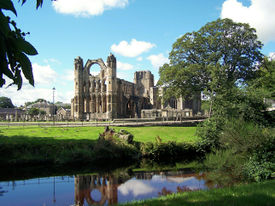
The citizens of Elgin and surrounding areas did not seem to object to the new religion following the Reformation. In 1568 the lead was stripped from the roof of the cathedral, following orders by the Privy Council. The lead was to be sold and the proceeds to go to the maintenance of Regent Moray's soldiers but the ship taking the lead cargo to Holland sank almost immediately on leaving Aberdeen harbour. Without this protection the building began to deteriorate. In 1637, the rafters over the choir were blown down and in 1640 the minister of St Giles along with the Laird of Innes and Alexander Brodie of Brodie, all ardent Covenanters, removed and destroyed the ornately carved screen and woodwork that had remained intact. The tracery of the West window was destroyed sometime between 1650 and 1660 by Cromwell's soldiers. On Easter Sunday, 1711, the central tower collapsed for the second time in its history but caused much more damage. The rubble was quarried for various projects in the vicinity until 1807 when through the efforts of Joseph King of Newmill, a wall was built around the cathedral and a keeper's house erected.
When Daniel Defoe made his tour through Scotland in 1717, he visited Elgin and said this about it
"In this rich country is the city, or town rather, of Elgin; I say city, because in antient time the monks claim'd it for a city; and the cathedral shews, by its ruins, that it was a place of great magnificence. Nor must it be wonder'd at, if in so pleasant, so rich, and so agreeable a part of the country, all the rest being so differing from it, the clergy should seat themselves in a proportion'd number, seeing we must do them the justice to say, that if there is any place richer and more fruitful, and pleasant than another, they seldom fail to find it out. As the country is rich and pleasant, so here are a great many rich inhabitants, and in the town of Elgin in particular; for the gentlemen, as if this was the Edinburgh, or the court, for this part of the island, leave their Highland habitations in the winter and come and live here for the diversion of the place and plenty of provisions; and there is, on this account, a great variety of gentlemen for society, and that of all parties and of all opinions. This makes Elgin a very agreeable place to live in, notwithstanding its distance, being above 450 measur'd miles from London, and more, if we must go by Edinburgh."
Unquestionably, the cathedral was, and still is, a magnificent building, worthy of its description as the Lantern of the North. When Bishop Bur wrote to King Robert III, complaining of the wanton destruction done to the building by the King's brother, the Wolf of Badenoch, he describes the cathedral as "the ornament of this district, the glory of the kingdom and the admiration of foreigners." Chambers, in his Picture of Scotland, says
"It is an allowed fact, which the ruins seem still to attest, that this was by far the most splendid specimen of ecclesiastical architecture in Scotland, the abbey church of Melrose not excepted. It must be acknowledged that the edifice last mentioned is a wonderful instance of symmetry and elaborate decoration; yet in extent, in loftiness, in impressive magnificence, and even in minute decoration, Elgin has been manifestly superior. Enough still remains to impress the solitary traveller with a sense of admiration mixed with astonishment."
Lachlan Shaw in his History of the Province of Moray was equally impressed when he wrote
"the church when entire was a building of Gothic architecture inferior to few in Europe."
Prince Charles Edward Stuart travelled to Elgin from Inverness in March 1746 and, falling ill with a feverish cold, stayed for 11 days before returning to await the arrival of the king's army. He stayed in Elgin with Mrs Anderson, a passionate Jacobite, at Thunderton House. She kept the sheets that the Prince slept on and was buried in them a quarter of a century later. The Duke of Cumberland passed through the town on 13 April, camping at Alves on the way to meet The Prince in battle on Drummossie Muir. After the battle, William Boyd, 4th Earl of Kilmarnock, one of the Prince's generals was captured and taken to London and eventual execution, but he wrote to his friend from prison about his indebtedness to the shoemakers of Elgin
"Beside my personal debts mentioned in general and particular in the State, there is one for which I am liable in justice, if it is not paid, owing to poor people who gave their work for it by my orders. It was at Elgin in Murray, the Regiment I commanded wanted shoes. I commissioned something about seventy pair of shoes and brogues, which might come to 3 shillngs or three shillings and sixpence each, one with the other. The magistrates divided them among the shoemakers of the town and country, and each shoemaker furnished his proportion. I drew on the town, for the price, out of the composition laid on them, but I was afterwards told at Inverness that, it was believed, the composition was otherwise applied, and the poor shoemakers not paid. As these poor people wrought by my orders, it will be a great ease to my heart to think they are not to lose by me, as too many have done in the course of that year, but had I lived I might have made some inquiry after: but now it is impossible, as their hardships in loss of horses and such things, which happeened through my soldiers, are so interwoven with what was done by other people, that it would be very hard, if not impossible, to separate them. If you'll write to Mr Innes of Dalkinty at Elgin (with whom I was quartered when I lay there), he will send you an account of the shoes, and if they were paid to the shoemakers or no; and if they are not, I beg you'll get my wife, or my successors to pay them when they can......"
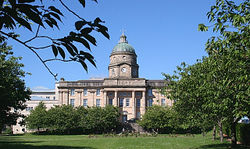
Into the 19th century and the old medieval town of Elgin was now to be swept away and the first major addition to the town centre was the Assembly Rooms, built in 1821 by The Trinity Lodge of Freemasons, at the corner of High Street and North Street. Two years before that, in 1819, Dr Gray's Hospital was built on unused ground. The building is imposing with its columns and dome and standing at the head of fine gardens.
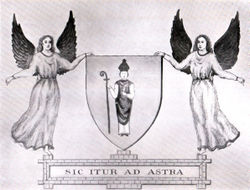
Dr Alexander Gray, a doctor who worked for and made his fortune with the East India Company endowed £26,000 for the provision of the hospital. In 1828 the new parish church of St Giles was built at a cost of £10,000. Lt. General Andrew Anderson, born in Elgin and who died in 1824, and also of the East India Company, bequeathed £70,000 to the town so that an institution could be provided for the welfare of the elderly poor people and for the education of the town's orphaned children. The Anderson Institute was built in the east end of the town in 1832 with accommodation for 50 children and 10 elderly people. The Burgh Court-house was built in 1841, the elegant museum in 1842 and the County Buildings in 1866.
The Morayshire Railway was officially opened at ceremonies in Elgin and Lossiemouth on 10 August 1852, the steam engines having been delivered to Lossiemouth by sea. It was the first railway north of Aberdeen and initially traveled only the 5½ miles between Elgin and Lossiemouth but later extended south to Craigellachie. The Great North of Scotland Railway took over the working of the line in 1863 and bought the company in 1881 following the Morayshire Railway's return from crippling debt back to solvency. The railway and Lossiemouth harbour became very important to Elgin's economy.
The town was becoming prosperous and by 1882 it had a head Post Office with a savings bank, insurance and telegraph departments, a Bank of Scotland and the British Linen Co., Caledonian, Commercial, North of Scotland, Royal and Union Banks, a National Securities Savings Bank, offices or agencies of 48 insurance companies, 5 Hotels and a newspaper. It was not until the 20th century, however, that the separate villages of Bishopmill and New Elgin would be incorporated into the town.
Geography and geology
The modern town straddles both sides of the River Lossie with the suburbs of Bishopmill to the north and New Elgin to the south. Permo-Triassic rocks even though rare in Scotland, are commonly found around Elgin. These are composed of aeolian sandstone and formed when this area was subjected to desert conditions. Quarry Wood, on the town's edge, has within it a formation nick-named Cuttie's Hillock which produced the internationally known fossils called the Elgin Reptiles. In the Elgin district, boulders belonging to the lowermost group of Jurassic strata, Oxford clay and chalk are found both in glacial deposits and on the surface of the ground. The largest of these deposits is at Linksfield, where limestone and shale lie on boulder clay.
Climate
Elgin's climate is temperate maritime having mainly cool summers but with relatively mild winters. Its proximity to the sea means that the heat retentive properties of seawater help keep winter temperatures higher. The barrier of the mountain ranges to the west and southwest where most of the moisture gathered in the Atlantic depressions is deposited help keep Elgin's annual rainfall to a relatively small amount.
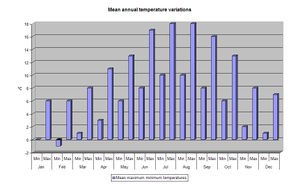
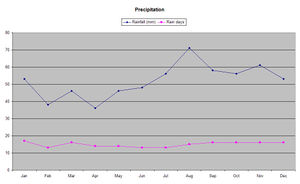
Source: http://uk.weather.com/
Demographics
|
|||||||
Source: Moray Council from 2001 Census data
Elgin's population in 1901 was 8460
Economy
The Elgin – Forres – Lossiemouth triangle is heavily dependent on the Royal Air Force stations for its employment of civilians. In 2005, RAF Lossiemouth along with its neighbour RAF Kinloss contributed £156.5 million (including civilian expenditure) to the Moray economy, of which £76.6 million was retained and spent locally. The bases are responsible for providing, directly or indirectly, 21 per cent of all employment in the area. Other areas offering significant employment are local authority, construction and real estate, food and drink, tourism, transport, business services and wholesale/retail.[3]
In a recent study, Elgin was shown to be one of the most expensive towns in which to buy property in Scotland.[4]
Politics
National governments
Elgin is in the Moray (Westminster) constituency of the The United Kingdom Parliament which returns a Member of Parliament (MP) to the House of Commons,[5] at Westminster.
Elgin is in the Moray constituency of the The Scottish Parliament[6] which has slightly different boundaries to the UK Parliament constituency of the same name. The constituency returns a Member of the Scottish Parliament (MSP) to Holyrood and is part of the Highlands and Islands electoral region.
Local government
- see also Moray council election, 2007
Following the re-organisation of local government in Scotland, Elgin now has 2 multi-member wards each with 3 councillors. These wards are Elgin North and Elgin South.
Transport
Elgin is situated on the A96 trunk route which connects the cities of Aberdeen and Inverness. High volumes of traffic passing through the town has given rise to serious congestion and Scottish transport minister Tavish Scott visited the town in August 2006 to look at the traffic management problems and to meet campaigners for a bypass. It is estimated that a bypass would remove about one third of traffic from Elgin's Streets. The A941 runs from Lossiemouth through Elgin to Rothes, Craigellachie, Dufftown and Rhynie. Elgin railway station is operated by First ScotRail. The railway also connects to Aberdeen and Inverness which in turn offer services to other UK destinations. A main bus station operated mainly by Stagecoach, provides services within Elgin and to other local towns while also providing routes to Aberdeen and Inverness. Inverness Airport at Dalcross, Inverness offers routes to mainly UK destinations while Aberdeen airport provides UK and international routes.
Education
Nursery schools
- Ark Childcare, Mosstowie
- Cherry Tree Nursery, Dr Gray's Hospital, West Road, Elgin, IV30 1SA
- Jack & Jill Pre-School Centre, Kinder House, 22 Wardend Place, New Elgin, IV30 6YP
- Moray Leisure Centre Pre-School Nursery, Boroughbriggs Road, Elgin, IV30 1AP
Primary schools
- Bishopmill Primary School, Morriston Road, Bishopmill
- East End Primary School, Institution Road
- Greenwards Primary School, Edgar Road, New Elgin
- New Elgin Primary School, Bezack Street, New Elgin
- Seafield Primary School, Deanshaugh Terrace, Bishopmill
- West End Primary School, Mayne Road
- St Sylvester's Primary School, Abbey Street
Secondary schools
- Elgin Academy, Morriston Road, Bishopmill
- Elgin High School, High School Drive, New Elgin
Further education
- Moray College, Moray Street, Elgin, Moray
Community care
Hospitals
- Dr Gray's Hospital
Health centres
- The Maryhill Health Centre.
- Linkwood Medical at the Glassgreen Centre (Formerly the Victoria Crescet Medical Centre before its relocation in 2009)
- Elgin Community Surgery, Highfield House.
Hospice
- The Oaks Hospice, Sherrifmill
Religion
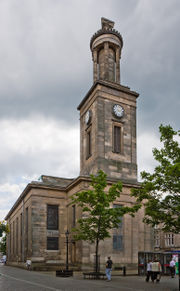
The following denominations have places of worship in Elgin:
- St Giles', High Street
- St Columba's South, Moss Street
- Elgin High, North Guildry Street
Free Church of Scotland
- Free Church, South Street
Baptist Union of Scotland
Roman Catholic Church
- St Sylvester's, Institution Road
Other denominations
- The Church of Jesus Christ of Latter-day Saints, Pansport Road
- Jehovah's Witnesses, Linkwood
- Calvary Christian Life Centre, Lesmurdie Road
- True Jesus Church, Lesmurdie Road
- Pentecostal Church of God, New Elgin Hall Annex
- Brethren, Riverside Gospel Hall, North Street
Culture and leisure
- Elgin Museum, 1 High Street
- Elgin Library, Cooper Park
- Elgin Golf Club, Hardhillock, Birnie Road
- Glassgreen Golf Range, Birnie Road
- Cooper Park: boating, pitch and putt, tennis
- Biblical Gardens
- Moray Leisure Centre, Borough Briggs Road, containing swimming pool, ice rink and a gymnasium
- Town Hall with auditorium for production of shows
- Community Centre, Trinity Road: badminton
- The Lantern Gallery, 18 South Guildry Street
- Red Shoes Theatre and music venue, High Street
- Elgin Youth Café, Francis Place
Sport
Football
Formed in 1893, the town's only senior football club is Elgin City, who play at Borough Briggs stadium. They entered the Highland Football League in 1895 and won the league championship fourteen times. The club entered the Scottish Football League in season 2000/01 and currently compete in in Division Three. Their home colours are black and white vertical stripes, black shorts and white socks. Past famous players for Elgin City include Andy Goram, Nicky Walker, Jimmy Johnstone and John McGinlay. Recently ex-Scotland players Brian Irvine and David Robertson have managed the club.
Two junior football sides, Bishopmill United and New Elgin, both currently compete in the Scottish Junior Football North Division Two while Moray Social, Golden Pheasant F.C. and Bishopmill Villa participate in the Moray District Welfare Football Association.
Rugby Union
Moray RFC was established in 1923 and play their home games at Morriston Playing Fields.
Cricket
Elgin Cricket Club play home games on the Cooper Park cricket pitch under the auspices of North of Scotland Cricket Association.
Twin town
Notable citizens
For full list, see Category:People from Elgin, Moray
- Sheriff William Wiseman. born about 1300, ancestor of Bishop of the Dromore Diocese (County Down) of the Church of Ireland, Capel Wiseman, 1635–1683, of Hertfordshire, who was forced to flee to the Continent following the accession of James II to the English Thronein 1685.
- Archbishop Mario Joseph Conti, born 20 March 1934. The Most Reverend Mario Conti is the current Archbishop of Glasgow, in Scotland. He studied for the priesthood at The Scots College (Rome) and was ordained a priest of the Diocese of Aberdeen in the Church of San Marcello al Corso, by Archbishop Luigi Traglia on 26 October 1958. He was parish priest in Caithness before becoming Bishop of Aberdeen, in 1977. In 2002, he was appointed to the archdiocese of Glasgow.
- Steven John Pressley, born 11 October 1973 is a Scottish international footballer currently playing for Falkirk F.C. in the Scottish Premier League. He plays as a defender, although he played as a striker during his school days at Inverkeithing High School. He is often known by his nickname, Elvis.
- General Andrew Anderson (1747–1824) Anderson was commissioned as an Ensign in 1766 in the army of the Honourable East India Company. He proved himself to be a fine officer progressing steadily through the ranks and by 1811 had reached the rank of Major General. It was possible to become very wealthy in the service as there were great prizes to be won and shared. Perhaps influenced by his own upbringing Andrew Anderson executed a Deed of Trust in 1815 by which he left £70,000 to the Sheriff and Magistrates and Clergy of the established church in Elgin to build and endow an Institution in Elgin to provide a home for fifty children where they would be educated sufficiently to enable them to earn a living. The Institution was also to give a home to ten aged persons. General Anderson died in 1824 in London aged 77 and in 1830 Elgin Town Council commenced building on the lands of Maisondieu. The fine building of the Elgin Institute for the support of Old Age and the education of Youth was opened in 1832.
- Dr Alexander Gray (d 1807), worked as a surgeon for the East India Company. His will was contested by his family, but eventually his bequest of £26,000 'for the establishment of a hospital in the town of Elgin for the sick and poor of the county of Murray (Moray)' was proven in the Court of Chancery, and work on building the hospital took place between 1815 and 1818. The hospital opened on 1 January 1819.
- Lt William Rennie, (1822–1887) 90th Perthshire Light Infantry, awarded Victoria Cross at Lucknow during Indian Mutiny, 1857
- William Dunbar (1749–1810) born in Thunderton House, Elgin. He was the youngest son of Sir Archibald Dunbar and Anne Bayne Dunbar. In 1763 he attended King's College, Aberdeen, and graduated from there in 1767. He emigrated to America arriving in Philadelphia in April 1771. In 1773 he and a Scottish merchant opened a cotton plantation in Florida and in 1792 opened another plantation in Mississippi. Dunbar became surveyor general in the Natchez area in 1798 and making his first meteorological observations in the Mississippi Valley in 1799. President Thomas Jefferson appointed him and fellow Scot Dr George Hunter to explore the Ouachita River region and travel all the way to the source of the Red River. They set out on 16 October 1804, traveling up the Ouachita River and on to the area of Hot Springs, Arkansas. Dunbar became the first man to give a scientific report of the hot springs, and his journal of the exploration was later published in Documents Relating to the Purchase and Exploration of Louisiana.
- William Latimer Duff (1822–1894) was the son of the Reverend William Duff, Minister of the St Giles Kirk. He was a pupil of Elgin Academy before moving to London and setting up in business. Duff emigrated to America and worked as a Commission Agent. He joined the Union army at the outbreak of the civil war and was commissioned as an artillery officer and became Assistant Inspector General on the staff of Ulysses S. Grant with the rank of Lieutenant Colonel. He was not present at the surrender of General Robert E. Lee at Appomattox as Grant had sent him on other duties. He left the army as Brigadier General of Volunteers on 13 March 1865 for his war service. He became U.S. Consul in Glasgow after the war until 1869 and then covered the Franco-Prussian war for the New York Herald and because of his military rank was accepted in Prussian Society and presented to the Kaiser Wilhelm I. He retired to Elgin where he died in 1894.
- Alexander Brodie Spark (1792–1856) became a leading banker, merchant & landowner in New South Wales. His diaries provide an intimate and detailed account of the social and business ties among the Scottish merchants and settlers, who formed their own social set and circle.
- Sir David Hardie (4 June 1856 – 11 November 1945) graduated as a doctor from Aberdeen University and practiced in Forres before emigrating to Australia and settling in Brisbane. He specialized in the diseases of women and children, particularly those arising from climate. In 1927 he became a founding fellow of the (Royal) Australasian College of Surgeons.
- Kevin McKidd born August 1973 was a member of the successful Moray Youth Theatre, Kevin left Elgin for University in Edinburgh after school. However he dropped out to pursue an acting career which has seen him star in British classic Trainspotting, cult horror Dog Soldiers, the critically acclaimed Sixteen Years of Alcohol, as well as the HBO/BBC venture Rome and Ridley Scott's Crusade epic Kingdom of Heaven.
- Margaret Masson Hardie Hasluck MBE (born 18 June 1885 - September 1947) Author and Anthropologist. Niece of Sir David Hardie, and also of James "Scotty" Philip's two brothers Alexander & George Philip. She lived in Greece and Albania, and during WW2 was involved with SOE from their base in Cairo, Egypt. She was acquainted with the novelist Olivia Manning and is reputed to be the character of 'Mrs Brett' in Olivia Manning's Balkan Trilogy 'Fortunes of War'.
- Frederick Fyvie Bruce (12 October 1910 – 11 September 1990) aka F.F. Bruce - Professor of Theology, author of numerous books and articles on theological subjects. He worked at Manchester and Sheffield Universities. Was a Fellow of the British Academy.
- Chris Clark, Plymouth Argyle football player
Notes
- ↑ Burgh Records of Scotland, Vol I, Preface, p.35
- ↑ Mackintosh, Herbert B: Elgin Past and Present, Elgin, 1914 p. 44
- ↑ http://www.hie.co.uk/ Highland & Islands Enterprise
- ↑ http://www.hbosplc.com/economy/includes/Scotlandposttownwinners2006FINAL.doc
- ↑ http://www.parliament.uk/about_commons/about_commons.cfm parliament.uk
- ↑ http://www.scottish.parliament.uk/home.htm scottish.parliament.uk
External links
- Census data
- Elgin Museum - Four Star Local Museum
- Elgin City FC - Official website of Elgin City FC
- Council - Moray Council
- Leisure Centre - Moray Leisure Centre
- [1] - Official website for the Elgin Youth Cafe
|
|||||||
